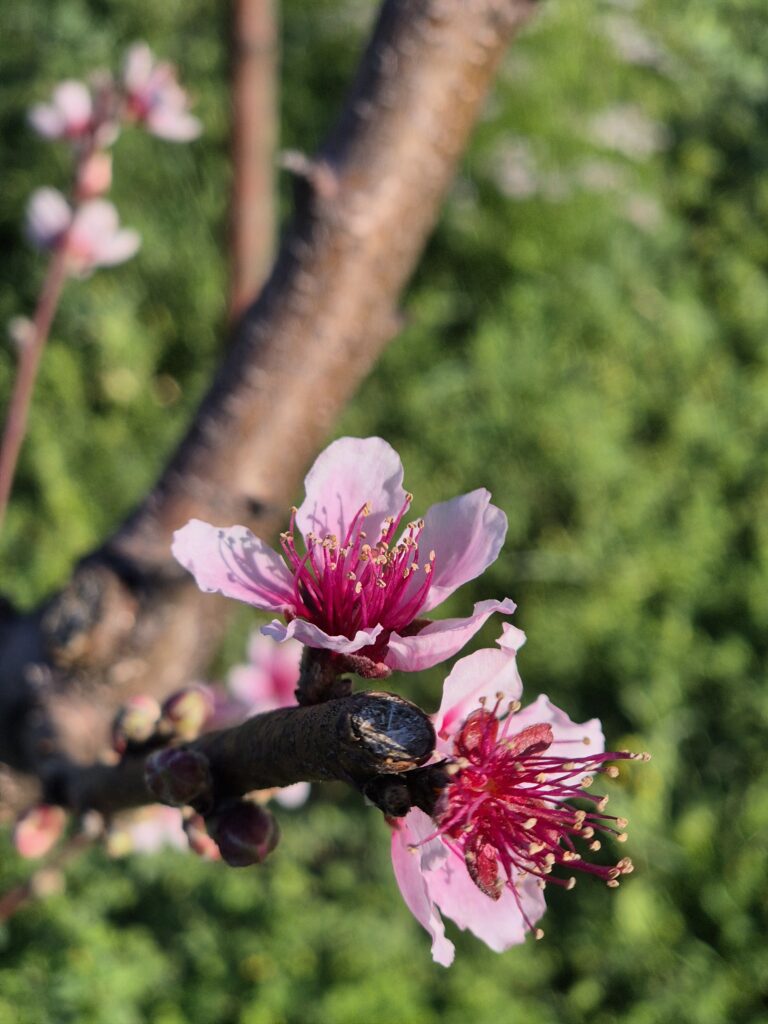Smallholders Orchards - Insights from Gram Bhawan, Village Baag
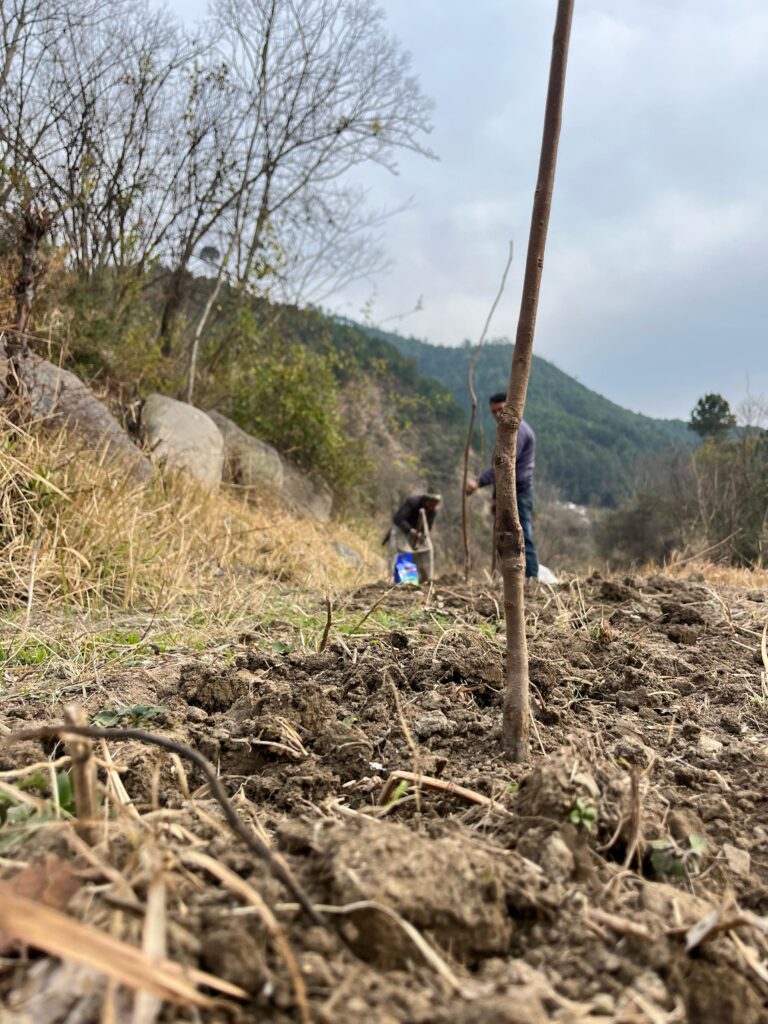
On February 16th, 2025:
I conducted my second visit to the Model Farm under development – Gram Bhawan at Village Baag, with the objective of assessing the condition of the plantation plots and checking the progress made since my last visit. This visit was crucial in implementing long-term orchard management strategies, particularly in the areas of pruning, soil nutrition, and pest control. While challenges persisted, it was encouraging to witness improvements that had taken place since the initial visit.
Progress Since the First Visit:
During my first visit on December 11th, 2024, a checkup of the orchard and surrounding farmland revealed significant challenges that required immediate intervention. Some of the issues observed included –
- Extensive weed growth – Large portions of the land were covered with uncontrolled weed growth, restricting the healthy development of crops and fruit trees. This occured due to lack of timely labour effort to deweed. During monsoon weed growth happens aggressively. As Gram Bhawan prohibits use of chemical Weedicides or Herbicides, it is important to de-weed often.
- Leaking canal – Himachal Pradesh has a traditional system of gravity irrigation called Kulh. For the first time the Goverment financed repair and construction of a Kulh at the farm. However, there were design and engineering issues by the masons during its construction. Incessant water flow from upstream and torrential rains damanged portions of the poor construction further. This impacted one of the fields, contributing to waterlogging and poor soil conditions. Crops were also lost and weed impact increased. Proper drainage is essential in orchard management as excessive moisture can lead to root rot and other fungal infections. The time taken for the repair work is unpredictable as the crop season progresses. As a result the practitioners at Gram Bhawan decided to make water gullies at each terrace to channelise flow of excess water from the fields and save the crops.
- Pest infestations and disease risk –Woolly aphids (Eriosoma lanigerum) and scale pests had begun damaging apple trees (Malus domestica), while papery bark, an early sign of canker (Neonectria ditissima), was observed in several plants. If not managed, these infestations could lead to significant yield losses.
- Poor nutrient management – The soil lacked adequate nitrogen, phosphorus, and potassium supplementation, leading to poor growth and stunted trees. Fruit trees require a balanced nutrient supply to produce healthy yields, and deficiencies in macronutrients like nitrogen (N), phosphorus (P), and potassium (K) can result in weak root development, poor fruit set, and increased susceptibility to diseases.
- Neglected field sections – Some sections of the farm had remained untouched due to leopard activity, making regular maintenance difficult. As a result, these areas had excessive overgrowth, creating a breeding ground for pests.
By the time of my second visit, it was evident that several corrective actions had been taken, significantly improving the orchard’s overall health –
- Weed removal had been completed. The fields were now clean and free from excessive weed growth, making way for better nutrient absorption and efficient land use. Mulching with weed residue was done on beds for the plants for moisture retention and soil degradation. Care is to be taken in ensuring that weed are cut and mulched before they form flowers or seeds, else they will grow back with greater vigour in the next season.
- Irrigation issues had been partially resolved. The leaking canal had been temporarily managed, although further repair work was still required.
- Pruning and Insect-pest control had been initiated. Several trees had undergone initial pruning, and pest treatments were planned for infected plants.
- Soil fertility had been slightly improved. Composting had been partially implemented, and recommendations for further soil improvement were provided.
- New plantation strategies were developed. Plans for introducing new fruit trees were being implemented to enhance diversity and sustainability.
Assessing the Orchard:
Upon arrival at 3 PM, we started pruning on Apple (Malus domestica), Plum (Prunus domestica), and other fruit trees. We worked closely with farm caretaker Bhupender Ji, demonstrating proper pruning techniques to enhance his understanding of tree maintenance. The trees had been sourced from Kalasan Nursery Farm (KNF), ensuring high-quality planting material. KNF is well known as a nursery to supply high quality disease free planting material. It also provides technical knowhow and guidance to smallholder farmers who wish to grow crops without agrochemicals. As these plants are expensive KNF takes followup care to ensure that the investment of Smallholders does not go to a loss. Gram Disha Trust, is developing such a model orchard and farm at Gram Bhawan, which shall be used as a reference in Future by all smallholders, who wish to develop orchards. These orchards, should be based on Agroecology – preferrably self-reliant Natural Farming, Economic Profitability and Socially viable. Thus these shall be based on aspects of Permaculture, Sustainable Agriculture, Regenerative production systems and market linked.
A closer evaluation of the apple plants revealed a concerning contrast. While some trees flourished, others remained severely nutrient-deficient or had perished altogether. The orchard lacked sufficient nitrogen, phosphorus, and potassium, leading to stunted growth and weak plant structures. Had a structured nutrient management plan and proper care been followed earlier, many trees could have been saved from deterioration.
To address this, KNF strongly recommended the addition of organic compost and bio-enhancers to improve soil fertility and ensure long-term soil health.
Challenges in Maintenance and Insect-Pest Infestation
While visible improvements had been made, several underlying challenges still required attention:
- Severe scale Insect-pest infestation – A number of trees were found to be highly infected with scale pests (Coccoidea), which, if left untreated, could significantly reduce orchard productivity. These pests weaken trees by sucking sap from branches, leading to poor fruit development and tree decline.
- Mismanaged tree structures – Many trees had overgrown branches requiring heavy pruning. Due to improper central leader management, some trees grew in irregular patterns, weakening their structural integrity. If the shape of the tree is not properly managed early on, it becomes difficult to achieve optimal light penetration and airflow, affecting fruit quality.
- Canker risk – The presence of papery bark on some trees suggested early signs of canker (Neonectria ditissima), which, if not controlled, could cause long-term orchard damage. Canker can cause wounds on the tree, making it susceptible to secondary infections.
- Need for tree replacement – Three trees were beyond recovery and had to be uprooted. These would be replaced with fresh apple saplings to restore the orchard’s productivity.
- New Plantations for Enhanced Bio-Diversity.
To revitalize the orchard and promote crop diversity, we introduced several new fruit trees and plants:
- Apple trees (Malus domestica): King Roat on M.9 rootstock and Decarli Gala on MM.106 were incorporated into the existing apple block. These are high-yielding, disease-resistant varieties suitable for high-density orchards.
- Persimmons (Diospyros kaki): Ten persimmon trees were planted alongside old plantations of pomegranate (Punica granatum) and plum (Prunus domestica) trees to enhance fruit variety. Persimmons are well-suited to the climatic conditions of Baag.
- Chandler Walnuts (Juglans regia): Two self-pollinating Chandler walnut trees were added in the last block to strengthen nut production. This variety is preferred for its high-quality nuts and excellent yield potential.
- Blackberries (Rubus fruticosus): Three blackberry plants were introduced. Two were placed at the backside of Gram Bhawan with support structures, while one was positioned near the sitting area, utilizing the retaining wall for structural support. Blackberries provide an additional revenue stream and ornamentation while improving biodiversity.
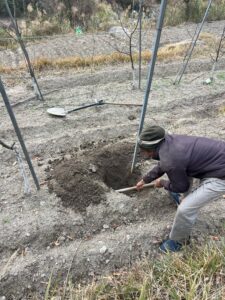
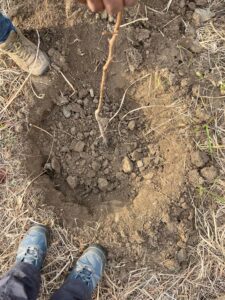
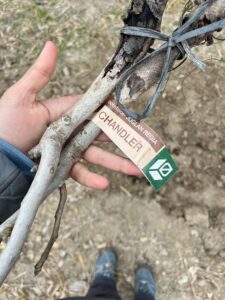
Implementing Sustainable Practices for Long-Term Growth
To secure long-term orchard sustainability, KNF recommended several key practices:
- Daily monitoring – Regular tree inspections to detect early signs of stress, pests, and diseases.
- Weed management – Continued efforts to maintain a weed-free environment to reduce competition for nutrients and prevent pest infestations.
- Pre-planting soil enrichment – Incorporating a special compost mix to enhance soil fertility before planting new trees.
- Dormant season pest control – Application of tree oil spray, completed by February 18th, to prevent pest eggs from hatching during dormancy.
- Organic fertilization and bio-enhancers – Cow dung compost, at a rate of 10 to 15 kilograms per plant, and Jeevamrit, a natural bio-enhancer, were recommended to improve microbial activity and strengthen plant immunity.
- Routine maintenance and cost reporting – Regular maintenance post-fruit bud stage was emphasized, alongside the preparation of expense reports for financial transparency and planning.
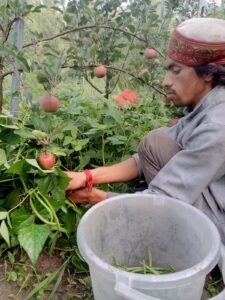
Future Outlook –
This visit reaffirmed the importance of structured and proactive orchard management. While challenges such as poor maintenance, pest infestations, and inadequate soil nutrition had affected productivity, the improvements observed since the first visit were noteworthy. By focusing on regular pruning, pest control, proper soil nutrition, sustainable land management, and strategic crop diversification, we can restore the orchard’s vitality and significantly enhance its long-term yield. Kalasan Nursery Farm, is one of the founding member of Gram Disha Trust and it strongly supports the efforts to develop this model orchard as a reference for other smallholders of the Karsog and Mandi area of Himachal Pradesh. Overall, once the orchard is developed and well managed, the results shall showcase that it is possible to have such smallholder orchards which are profitable and Environmently aligned for Sustainable Agrifood Systems.

